
Bellows Falls is an incorporated village located in the town of Rockingham in Windham County, Vermont, United States. The population was 2,747 at the 2020 census. Bellows Falls is home to the Green Mountain Railroad, a heritage railroad; the annual Roots on the River Festival; and the No Film Film Festival.
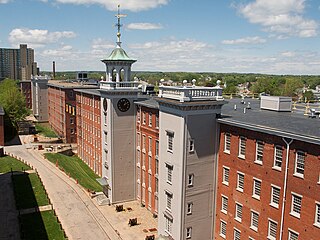
Lowell National Historical Park is a National Historical Park of the United States located in Lowell, Massachusetts. Established in 1978 a few years after Lowell Heritage State Park, it is operated by the National Park Service and comprises a group of different sites in and around the city of Lowell related to the era of textile manufacturing in the city during the Industrial Revolution. In 2019, the park was included as Massachusetts' representative in the America the Beautiful Quarters series.

Cannelton Cotton Mill, also known as Indiana Cotton Mill, is a National Historic Landmark of the United States located in Cannelton, Indiana, United States. Built in 1849 as an effort to expand textile milling out of New England, it was the largest industrial building west of the Allegheny Mountains, designed by Thomas Alexander Tefft, an early industrial architect. It was declared a National Historic Landmark in 1991. The building now houses residences.

Montgomery Union Station and Trainshed is a historic former train station in Montgomery, Alabama. Built in 1898 by the Louisville and Nashville Railroad, rail service to the station ended in 1979 and it has since been adapted for use by the Montgomery Area Visitor Center and commercial tenants. It was added to the National Register of Historic Places in 1973 and became a National Historic Landmark in 1976.

The Swann Covered Bridge, also called the Joy Covered Bridge or Swann-Joy Covered Bridge, is a county-owned, wood-and-metal combination style covered bridge that spans the Locust Fork of the Black Warrior River in Blount County, Alabama, United States. It is located on Swann Bridge Road off State Route 79, just west of the town of Cleveland, about 10 miles (16 km) northwest of Oneonta.

Oconaluftee Archeological District is within the eponymous river valley in the Great Smoky Mountains of North Carolina, located in the Southeastern United States. Formerly a historic Cherokee village, followed by an Appalachian community, were located at this site along the Oconaluftee River. Now the site serves as the main entrance to the North Carolina side of the Great Smoky Mountains National Park.

Kymulga Mill & Covered Bridge are two locally owned historic landmarks located at Kymulga Park in Talladega County, Alabama, United States. The park is on Grist Mill Road off State Route 76 about 4 miles northeast of the city of Childersburg.

The Mansfield Roller Mill or Mansfield Mill is a (gristmill) that was built in Mansfield, Indiana, United States by Jacob Rohm in 1875. This building replaced an older mill that dates back to 1821 built by James Kelsey and Francis Dickson;

The Baxter Mill is a historic gristmill on Massachusetts Route 28 in West Yarmouth, Massachusetts. Built about 1710 and restored to working order in 1961, it is the only surviving 18th-century water-powered mill on Cape Cod. It is now a museum property owned by the town and operated by the Yarmouth Historical Commission. The mill was listed on the National Register of Historic Places in 1981.

The Old Greene County Courthouse is a historic courthouse in Eutaw, Alabama, United States. It housed the seat of government for Greene County from 1869 until 1993. The building is a two-story masonry structure in the Greek Revival style with Italianate influences. Architect Clay Lancaster proposed that it may be the last Greek Revival public building to be built in Alabama. It replaced an earlier wooden courthouse on the same site that was built in 1838. The prior courthouse was burned in 1868, in what is considered by most historians to have been a deliberate act of arson that was executed to destroy indictments brought by the recently installed Radical Reconstruction government against local citizens. The fire destroyed paperwork pertaining to some 1,800 suits by freedmen against planters which were about to be acted on. The courthouse was placed on the National Register of Historic Places on March 24, 1971, due to its architectural significance.

The Brierfield Furnace, also known as the Bibb Naval Furnace and Brierfield Ironworks, is a historic district in Brierfield, Alabama, encompassed by Brierfield Ironworks Historical State Park. The district covers 486 acres (197 ha) and includes one building and nine sites. It was listed on the National Register of Historic Places on November 20, 1974.

The Fremont Mill Bridge near Anamosa, Iowa was built in 1873. Its superstructure was designed and built by Massillon Iron Bridge Company and its foundations were built by James Milne. It is a wrought iron bowstring through arch bridge.

Boshell's Mill is the historic site of a gristmill and sawmill on Lost Creek near Townley in rural Walker County, Alabama. The 4-acre (1.6 ha) site was listed on the National Register of Historic Places in 1975. It was recorded by the Historic American Engineering Record as part of the Birmingham District in 1992.
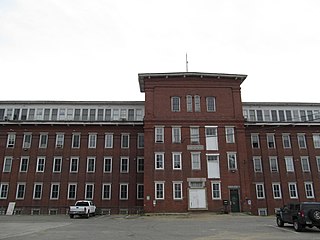
The Salmon Falls Mill Historic District encompasses a historic mill complex on Front Street in Rollinsford, New Hampshire. The complex includes four major structures and seven smaller ones, on about 14 acres (5.7 ha) of land along the Salmon Falls River. They were built between about 1840 and the mid-1860s, and have an unusual architectural unity, for additions made to the buildings were done with attention to matching design elements from the existing structures. The Number 2 Mill, built in 1848, was an early location where a turbine was used instead of a waterwheel to provide power to the mill machinery. The district was listed on the National Register of Historic Places in 1980.

The Neligh Mill is a water-powered flour mill in the city of Neligh in the northeastern part of the state of Nebraska in the Midwestern United States. The mill was built in 1873 by John Neligh, the city's founder, to make use of water power from the Elkhorn River. It operated for nearly one hundred years until it closed in 1969.
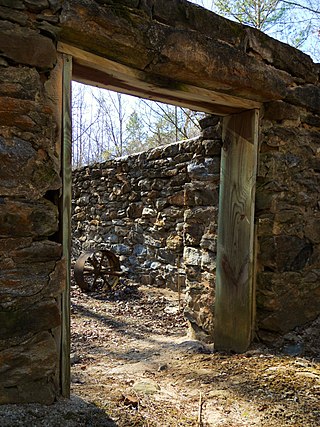
The McCosh Grist Mill is a historic grist mill near Rock Mills in Randolph County, Alabama. The mill was built in the early 1870s, and is the oldest extant stone grist mill in Alabama. It was built by James Eichelburger McCosh, whose grandfather, Jacob Eichelburger, operated earlier mills that were similar to those in his native Pennsylvania. McCosh also owned 500 acres of farmland nearby, and later added a cotton gin to the site. The mill operated until 1958, and was purchased in 1970 by the United States Army Corps of Engineers as part of the West Point Lake reservoir project.

The Dinsmore Grain Company Mill was a historic early 20th-century mill building on Branch Mill Road in China, Maine, USA. Built in 1914 on a site with nearly 100 years of industrial use, it was a well-preserved and functional period water-powered grist mill and sawmill. It was demolished in 2017, and delisted from the National Register in 2023.
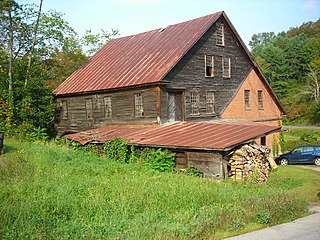
The Hayward and Kibby Mill, also known as the Tunbridge Mill, is a historic industrial facility on Spring Road in Tunbridge, Vermont. It includes a substantially complete water-powered 19th-century grist mill dating back to 1820, with a later sawmill added about 1870. It is one of the few surviving water-powered mills in the state, and is believed to be the only one featuring both a sawmill and grist (grain) mill. It was listed on the National Register of Historic Places in 1992.
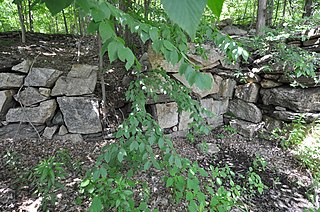
The Hitchcock-Schwarzmann Mill was a historic industrial building at the junction of Foote and Vineyard Roads in Burlington, Connecticut. Built about 1781 and repeatedly enlarged and altered, it was the town's only surviving 18th-century mill building. It was listed on the National Register of Historic Places in 1977, and has subsequently been demolished.
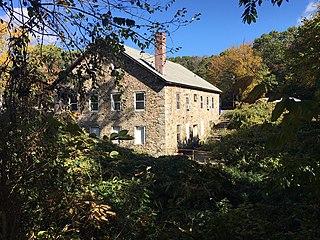
The Otis Angell Gristmill is a historic mill in Governor John Notte Memorial Park, North Providence, Rhode Island. Built about 1855, it is a well-preserved example of a small 19th-century industrial site, with a stone mill building and a small mill pond. The site was added to the National Register of Historic Places in 2017. The mill building now serves as a local community center.






















